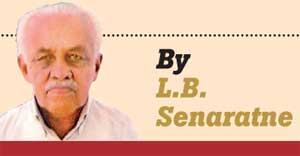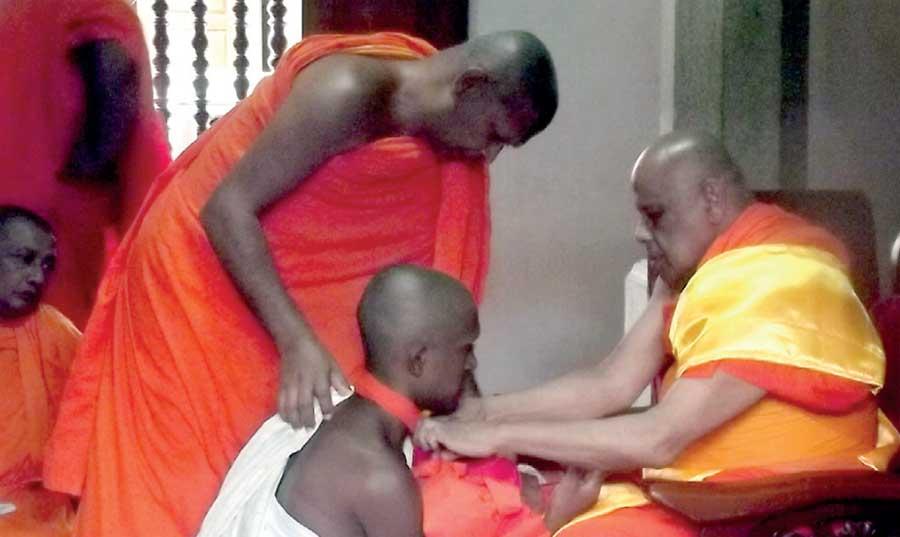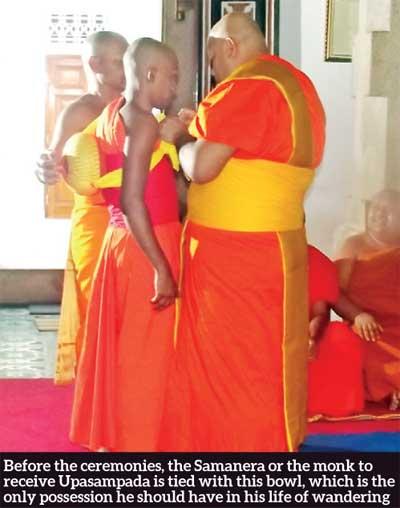Reply To:
Name - Reply Comment
The 166th Upasampada ceremonies at Asgiriya and Malwatta Chapters were held recently under the patronage of  Mahanayake of Malwatta Ven. Thibbotuwawa Sri Sumangala Thera and Mahanayake of Asgiriya Ven. Panditha Anamaduwe Sri Gnanaratne Thera.
Mahanayake of Malwatta Ven. Thibbotuwawa Sri Sumangala Thera and Mahanayake of Asgiriya Ven. Panditha Anamaduwe Sri Gnanaratne Thera.
Although Upasampada was brought to Sri Lanka in 1753, most of us have forgotten the fact that during the reign of King Parakramabahu the Great (1153 AD) – a supporter of Theravada Buddhism – the seventh Buddhist Council was held under the chairmanship of
Kassapa Thera of Dimbulagala.
In 1872, British national J.F. Dickson who acted as the Government Agent was invited to watch the proceedings of Upasampada Karmaya. He later translated Upasampada Kammavaca at the Malwatta Maha Vihara. Later in 1776, this manual was translated to Italian by Padre Maria Percoto (Missionary in Ava and Pegu) titled ‘Kammava, ossia trattato della ordinazio dei Talapini del secondo orine detti Penzi’ and a portion of it was edited in 1841. It is recorded that this translation had been handed over to the Pope at that time -- it has been said that the Pope had made use of some extracts for the ordination of bishops.
People from neighbouring countries including Burma, Thailand(then known as Lanna), Pegu (lower Burma) and Cambodia flocked to Sri Lanka to acquaint themselves with Buddha Dhamma. Thailand too sent monks to learn and obtain Upasampada rites. The rites were taken to Thailand and became known as Lankavamsa rites.
During the reign of Thai King Khunrajiajhaeng, two Sri Lankan monks were resident in a temple at Nakhon Si Thammarat in Thailand. The king was so moved by the rites being brought to his country. He is said to have warded off his royal prestige and gone down to the monastic head of the Sangha where Sri Lankan monks resided. It is recorded that it was during this time that a Buddha image was sent to Sukhothai from Sri Lanka.

Mahanayake of Asgiriya Ven. Pandith Warkagoda Sri Gnanaratne Thera reciting the precepts at ‘Poyage ‘ to ‘Wahal-Nagaya’ Samanera before he is bestowed Upasampada
In ancient Thailand, there were two groups of monks: Mon and Lana. In the reign of Saenmuengma, Lana monks headed by the Elder Medhankara came to Sri Lanka with two other prelates for re-ordination and then returned to Lana (Thailand). The 166th Upasampada ceremonies at the two established Maha Viharas ended on Poson Day, where rites were brought to the country when there was not a single monk with ‘Upasampada Karmaya’ or higher ordination. This was during the time of Sangharaja Weliwita Asarana Saranankara Thera of Tumpane.
"The process of Upasampada is for the Samanera to be ‘disrobed’ and attired in clothes of a Kandyan layman but without the jacket and then be taken in procession escorted by relations and well-wishers to the respective Maha Vihara for the ordination ceremony"
It is also recorded that it was during this epoch that the Buddha image ‘Sihing’ was taken from Sri Lanka to Nakhon Si Thammarat and the elder Dhammkitti and his followers came to study Buddhism in Sri Lanka.
The age-old custom of Upasampada continues in Sri Lanka with all rites and rituals since 1753. The fact is that this rite fulfils the end of a Samanera monk and by uplifting the Samanera to the status of a fully-fledged monk which is the ultimate goal of any monk who has entered Sasana. It is noteworthy that this tradition continues in the same form both at Malwatta and Asgiri Viharas since 1753. But there came a time when Sri Lanka did not have a single monk who had been ordained with Upasampada rites and it was Weliwita Asarana Sarana Sarankara Thera who took the initiative to request King Kirthi Sri Rajasinghe to bring these ceremonies back to Sri Lanka, from then Siam, from which on the two Maha Viharas became ‘Siam Nikayas.’
The temples fell into disuse and the Sangha was interested in mundane affairs rather than serving people’s wants. A class of monks known as “Ganinnanseas” sprung up and did more damage than the teachings of the Buddha. In fact, Buddhism fell into an abyss and Catholicism spread quickly in these circumstances in the Kandyan Kingdom.
Upasampada was also held in Burma and some 500 monks had come to Sri Lanka and performed these rites, but they did not go far. The only person who was left with these rites from Burma was Venerable Siriyagoda Rajaguru Thera under whom Venerable Weliwita Sarnakara Threa took refuge.
Welivita Saranankara Thera entered Bhikkuhood under the then learned Venerable Suriyagoda Rajaguru Bhikkuni at Suriyagoda Temple in Yatinuwara. Books were rare but the Venerable Suriyagoda Rajaguru had certain important books.
It was during this period that the young monk formed an organisation called “Silvath Samagama.” In numerous ways, he fell foul with the feudal and was banished to Laggala without the knowledge of king. He was brought back and in the course of time.
 King Kirthi Sri Ranasinghe sent the last emissary to bring Upasampada to Sri Lanka as earlier emissaries had failed. A delegation of 32 monks arrived in Sri Lanka headed by Upali Maha Thera.
King Kirthi Sri Ranasinghe sent the last emissary to bring Upasampada to Sri Lanka as earlier emissaries had failed. A delegation of 32 monks arrived in Sri Lanka headed by Upali Maha Thera.
On Esala full moon day, Upali Thera and the Siamese monks arrived to an adapted area now known as ‘Poyage’ in Malwatta Maha Vihara to be ordained with Upasampada, firstly on Weliwita Thera. But the prelate had said he must have a monk senior to him in order to pay obeisance. Thus Venerable Kobbekaduwa Siri Nivasa, the Maha Nayake at that time, was first ordained with Upasampada followed by Sarankara, Hulangamuwa Bambaradeniya, Thibbotuwawa and Navinne.
Upali Maha Thera who witnessed the Kandy Esala Perahera of Devalas was astonished that the Sacred Tooth Relic was not taken in procession. He questioned the king. So King Keerthi Sri Rajasinghe, the following day itself, brought the Sacred Tooth Relic into the procession and headed the Perahera of the Devalas. He saw to it that priests followed the tusker who carried the Sacred Tooth Relic.
But the priest who was very close to Sarankara Thera Sitimaluwe Unnanse was denied Upasampada as he was considered ‘non-Goigama.’ So the Upasampada ceremonies continued…
After King Kirthi Sri Rajasinghe elevated Saranankara Thera to the status of Sangharaja, Ven. Sri Siddhartha Buddharakita Thera became the first Mahanayake at Malwatta and the Mahanayake of Asgiri was Urulawatte Siridhamasiddi.
The first Sangharaja was from Kotte who was Ven. Kotte Vidyagama Maithree Sangharaja. After his demise, there was no Sangharaja until King Keerthi Sri Rajasinghe elevated Ven. Weliwita Thera as Sangharaja.
In fact, there was no Diyawadana Nilame for Sri Dalada Maligawa as it was private property of the king. The Diyawadana Nilame was there to assist in the bath for the king with Saluwadana Nilame. The Diyawadana Nilame was the 43rd lay official in the Kandyan Kingdom in the list of precedence.
The process of Upasampada is for the Samanera to be ‘disrobed’ and attired in clothes of a Kandyan layman but without the jacket and then be taken in procession escorted by relations and well-wishers, especially from the village of the Samanera to the respective Maha Vihara, either Asgiri or Malwatta, for the ordination ceremony. This ceremony is conducted at both viharas as much as it was in 1753.
The Samanera’s who receive Upasampada on the four Poya days and crowned at Maligawa are known as ‘Wahal- Nagaya’ or in other words, the Samanera of the king.
After the British took over the administration of the Kandyan provinces, the Governor and later the Governor-General followed by the President sends an Atapirikara to be presented to the ‘Wahal-Nagaya’ Samanera on each full moon Poya day between Vesak and Poson.
Since of late, the Buddhist Affairs Department sends to every monk who had been higher ordained throughout the period from Vesak to Poson, an Atapirikara and his travelling expenses.